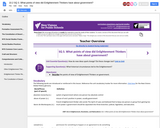
New Visions: Intro to Enlightenment
- Subject:
- History
- World History
- Material Type:
- Primary Source
- Provider:
- New Visions for Public Schools
- Date Added:
- 08/29/2018

New Visions: Intro to Enlightenment

In January 1863, President Lincoln’s Emancipation Proclamation went into effect, and the Union Army began recruiting Black Americans to fight the Civil War. Thousands answered the call. Soldiers of the 54th Massachusetts infantry regiment came from all over the country, dedicated to both the destruction of slavery and the advancement of racial equality nationwide. Their heroism transformed the conflict from a battle to preserve the Union to a grand struggle for freedom. Discover the true story of the men whose fame was restored to public memory by the celebrated 1989 film Glory. The Woodson Center's Black History and Excellence curriculum is based on the Woodson Principles and tells the stories of Black Americans whose tenacity and resilience enabled them to overcome adversity and make invaluable contributions to our country. It also teaches character and decision-making skills that equip students to take charge of their futures. These lessons in Black American excellence are free and publicly available for all.

Students will examine how patriotism comes in many forms through an analysis of the short film "Patriotism and Protest." In the film, experts and Minidoka survivors highlight how the infamous "loyalty questionnaire" during WWII divided the Japanese American community.

Students will examine how news outlets and government propaganda shaped war hysteria and racism against Japanese Americans during WWII. In the short film, "Power of the Press," students will learn about the pre-war racism against Asian Americans and how community allyship can have a profound effect in combating propaganda.

Students will examine how language shapes public perception through an analysis of the short film "Power of Words." In the film, experts highlight the various euphemisms used by the US government to describe the WWII incarceration of Japanese Americans and how the language used to describe this event did not match the reality.

Students will examine the responsibility of citizens through an analysis of the short film "Standing Up for Others." In the film, Japanese Americans draw parallels between their experience during World War II and the experiences of Muslim Americans and asylum-seeking migrant children.

In this history lesson, students learn about the epic life and exemplary character of Biddy Mason, a woman who was born into slavery in the Deep South, walked to California as part of a pioneer caravan, fought for her freedom in court, and died a millionaire real-estate investor in Los Angeles. In addition to the highs and lows of Biddy’s dramatic life, this lesson asks students to study how she demonstrated the virtues of courage and charity, both in securing freedom for herself and her family and, later, using her fortune to invest in her community and provide relief to poor Californians of all races and religions.The Woodson Center's Black History and Excellence curriculum is based on the Woodson Principles and tells the stories of Black Americans whose tenacity and resilience enabled them to overcome adversity and make invaluable contributions to our country. It also teaches character and decision-making skills that equip students to take charge of their futures. These lessons in Black American excellence are free and publicly available for all.
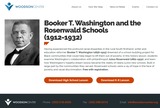
Having experienced the profound racial disparities in the rural South firsthand, writer and education reformer Booker T. Washington (1856-1915) dreamed of a school-building project for Black communities that could help begin to lift them out of poverty. In this history lesson, students examine Washington’s collaboration with philanthropist Julius Rosenwald (1862-1932), and learn how Washington’s hopeful dream slowly became the reality of nearly 5,000 new schools. Built in large part by the communities they served, Rosenwald schools were a ray of hope in the face of poverty and racial discrimination.The Woodson Center's Black History and Excellence curriculum is based on the Woodson Principles and tells the stories of Black Americans whose tenacity and resilience enabled them to overcome adversity and make invaluable contributions to our country. It also teaches character and decision-making skills that equip students to take charge of their futures. These lessons in Black American excellence are free and publicly available for all.

Jennifer Connell was called the “Worst Aunt Ever” on Twitter after she sued her cousin’s son over a broken wrist. The story, full of misinformation and inaccuracies, went viral. This video and accompanying lesson plan helps students learn how to fact-check a sensational story using a technique called lateral reading.
This lesson is not under an open license; however it is provided free for educational services.

In this history lesson, students learn about the ingenuity and entrepreneurial spirit of Elijah McCoy, a prolific inventor who held 57 patents, mostly on designs related to locomotives. Born in Canada and educated in Scotland, he spent most of his professional life in and around Detroit, Michigan, working in the railroad industry while also continuing to produce new inventions. The son of escaped slaves, McCoy overcame early discrimination to become an internationally respected authority in his field. By the time of his death, McCoy was widely celebrated by his contemporaries as a leader and model for Black America in the first generation after Emancipation. This lesson asks students to consider how McCoy’s life experiences led him create such important innovations and ask why his inventions were so highly valued by manufacturers and consumers. The Woodson Center's Black History and Excellence curriculum is based on the Woodson Principles and tells the stories of Black Americans whose tenacity and resilience enabled them to overcome adversity and make invaluable contributions to our country. It also teaches character and decision-making skills that equip students to take charge of their futures. These lessons in Black American excellence are free and publicly available for all.
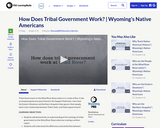
Tribal Government on the Wind River Reservation is in a state of flux. In the accompanying lessons plans (found in the Support Materials), learn how the Eastern Shoshone and Northern Arapaho tribes govern their people, what is the relationship between Tribal, State, and Federal government?
LEARNING OBJECTIVES:
Students will demonstrate an understanding of the workings of tribal government on the Wind River Reservation by creating a written report.
Students will understand the differences and similarities between state, tribal and federal governments and their functions, structures, and powers.

The Miss Indian America Pageant was launched by Sheridan residents in the 1950's to combat discrimination. In the accompanying lesson plan (found in the Support Materials) students will view the story told through the eyes of Miss Indian America title holders who held a reunion in 2013, serving as grand marshals in the Sheridan, WY Rodeo parade and commemorating a legacy of bridging cultures.
LEARNING OBJECTIVES:
Students will identify the reason why the town of Sheridan, WY started the Miss Indian America Pageant.
Students will define the given vocabulary words.
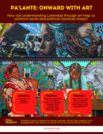
Students begin this unit by discussing their relationship with art, and the extent to which they believe art drives resistance movements. Students then participate in a Gallery Walk that highlights how members of the Puerto Rico community in the Young Lords used art to advance their ideas and preserve their culture. Students center the activism of Indigenous peoples in Puerto Rico by studying bomba music and murals. This helps them understand the roots of art—both visual and performance—as activism, and respond to the question: How can understanding Latinidad through art help us confront social and political injustices? Throughout this unit, students work in teams to create a poster series that inspires civic engagement and action on issues of social and political injustice.

In the first bend of this unit, students will closely read multiple perspectives on the “American Dream” in
order to collect information to use and integrate that information into an evidence-based perspective.
Students will examine primary and secondary source documents to make informed decisions about
what information to collect that may inspire their writing about “The American Dream.”
In the second bend of this unit, students will engage in a short-research process to create a draft of
argumentative speech on the “American Dream” with a specific purpose, audience, and tone in mind.
They will use their inquiry research questions from bend one to begin analyzing search results and citing
and gathering relevant, accurate, and credible information.
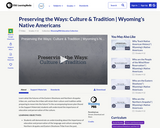
Learn what the futures of the Eastern Shoshone and Northern Arapaho tribes are, and how the tribes will retain their culture and tradition while preparing to move into the future? In the accompanying lesson plan (found in the Support Materials) students will understand the importance of education and perservation of the culture.
LEARNING OBJECTIVES:
Students will demonstrate an understanding about the importance of education and preservation of the language and culture among the Northern Arapaho and Eastern Shoshone Tribe from the past, present, and future.
Students will learn about the Federal Indian Policy to civilize Native Americans through the establishment of Native American Boarding Schools incorporating key vocabulary words.
Students will learn about how the practice of forced assimilation contributed to the diminished use of the Shoshone and Arapaho people’s lifestyle, languages, and traditions.
Students will discuss the development of Indian boarding schools in the United States and Wyoming.
Students will analyze the differences between the early educational experiences of the Native American and non-native students.
Students will examine the importance of education as a value that the Shoshone, Arapaho, and non-native communities share.
Students will consider how Native American students and non-native students can learn from each other to dispel the myths and stereotypes that exist in contemporary society.
Students will learn why oral traditions are important.
Students will understand why respect for elders is important in the tribe.
Students will gain an awareness of why traditional dancing and singing is important to traditions and culture.
Students will explore the significance of the buffalo to the Shoshone people living on the Wind River Reservation.
Students will learn that through traditional concepts of understanding, the Shoshone people, as well as many other Plains tribes, were able to survive through their sustenance on the buffalo.
Students will discuss the relationship that Native American people have with the buffalo (i.e., spiritual, sustenance, etc.) and how oral traditions play a critical role in the preservation of Native ways of knowing.

This document describes a series of lessons in the Social Sciences, all of which are tied to the exploration of the United Nations Universal Declaration of Human Rights (UDHR) as a Primary Source Document. They are designed to be given to 9th or 10th grade students in a World History, Cultural Geography, or similar social science class. They are specifically designed to teach the Common Core Standards for Literacy in the Social Sciences, and to engage higher order thinking skills.
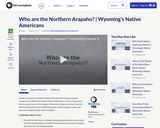
Students will gain an understanding of the Northern Arapaho people located on the Wind River Reservation in Wyoming. In the accompanying lessons plans (found in the Support Materials), students will learn how the Northern Arapaho come to Wyoming, what are the Arapaho values, and why were Arapaho tribal names changed?
LEARNING OBJECTIVES:
Students will be able to evaluate what geographical places were used by the Arapaho people and understand how historical events changed the future for the Arapaho people.
Students will compare and contrast between their social and ceremonial structures.
Students will understand the hierarchy of the Arapaho Tribe.
Students will analyze how their social and ceremonial structures contribute to their cultural identity.